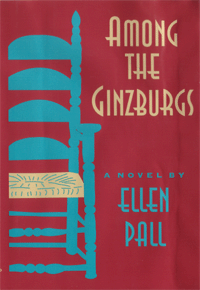

![]()
From The New Yorker July 8, 1996
The ironic detachment of the middle-aged Ginzburg
children is their charm. It is also their curse, as the fifth, and youngest,
of them sees when they gather for a weekend of friendly insults, shared carping,
listening to Procol Harum, and watching their brilliant but feckless father
die. The sentences uttered by these literary descendants of Salinger=s Glass
family are good enough to eat. So are the sentences that describe them.
From Publishers Weekly, April 22, 1996
There are no villains or heroes in this perceptive, poignant examination of family; whatever a character=s surface traits--foppery and vanity, or nobility and self-sacrifice--Pall (Back East, 1983) digs deep to expose the sweetness and vulnerability that are at each one=s core. On a rainy autumn weekend at their family=s farmhouse in the Catskills, the five adult Ginzburg children and three of their mates gather for the first time in many years. The reason: their father, Meyer, who abandoned them and their mother 28 years ago, has returned home to die. At first shunning Meyer, who lies upstairs reflecting on his fragmented life with increasing detachment, the various Ginzburgs engage in the reminiscing, raillery, crying and feuding that are particular to siblings. Take away the wise and analytical commentary and this is a classic drawing-room drama set in a country house; the theatricality is further enhanced by the presence of famous actor Anatole, the husband of the second youngest Ginzburg. But Pall never descends to cheap theatrics and instead puts a clever and always gentle twist on scenes that in less able hands would be cliched and melodramatic. Dialogue, characterizations, setting--all ring true in this mature, gracefully realized work.
June 2, 1996, Sunday, Family Plot by Wendy Wasserstein, New York Times Book Review
Meet the Ginzburg kids, the two "Bigs" and the three "Littles." There are the 40-somethings: Mark, a former lawyer, who's given up the rat race to live in the Catskills, and Charlotte, a twice-married dermatologist. In the middle are Sunny, an acidic journalist, and Ira, a single, post-druggie environmentalist. And, finally, Mimi, the baby, an ever-promising singer-waitress. Collectively they are currently hitting every midlife and cusp-of-midlife milestone, including infidelity, infertility, unmarried pregnancy, menopause, reconciliation and resignation.
Gathered together, however, in upstate New York for the last days of their errant father, Meyer, the remaining Ginzburg family confronts the ultimate passage, the death of a parent. It's tricky to still blame everything on daddy, even a daddy like Meyer, who has been absent for 28 years and is about to make his final exit. The structure of "Among the Ginzburgs," Ellen Pall's extremely readable novel, is a very theatrical one. A disparate cast of characters -- siblings and not -- with shifting and complicated alliances, coming together for a weekend in the hope of the ultimate recognition scene, is a familiar dramatic device. In Richard Nelson's play "New England," Americanized British siblings find their way to their deceased father's farm in Vermont. "The Big Chill" relied on the weekend-reunion plot for a group to evaluate its bonds of friendship; in the Ginzburgs' case the bonds are familial as well. There must be something about playing the music of Procol Harum and Bob Dylan's "Blonde on Blonde" that causes fictional Americans of a certain age to evaluate past, present and future.
Given the theatrical structure of the novel, it is not surprising that Sunny Ginzburg's husband, Anatole Bronski, is an actor. He is currently starring on Broadway in "Crushed Velvet"; by the end of the novel he is in "Aunt Addie's Bouquet." (One wishes that nonfictional Broadway actors had as many vehicles to star in as Anatole seems to.) Sunny, with her intelligent journalist's distance, watches the acts of her family's reunion unfold. On the night her father dies she muses to herself that "the evening's events seemed curiously predetermined. Like a play."
Among the Ginzburgs, secrets are packed in with the toothpaste. Sunny is not coping with expensive, invasive infertility treatments, and is fearful of ovum donation. Mark, who is a good man intent on living a good life, recently abandoned his wife for a county clerk, and Ira, the boy who prefers bugs to girls, can't seem to merge sex and love. But the biggest secret-keeper of all is the pater-non-familias who dumped them so many years ago for a 23-year-old suicidal poet. Meyer's life since then is a complete mystery. The only thing that's clear is that this intelligent, erratic, selfish man has profoundly, though without premeditation, altered the lives of his five children. Each of the unhappy Ginzburgs is unhappy in a different way.
Most of the action of "Among the Ginzburgs" is "A Coupla Jewish Siblings Sitting Around Talkin'." However, it's not the talk that gives this novel its honesty, but the insights that Ms. Pall, the author of the novel "Back East," has about unspoken family ties. In dissecting the family's motivations, she breaks down her dramatic structure and is free to examine with absolute acuity the ever expanding and contracting familial pull of brothers and sisters, husbands and wives.
During Meyer's final hours, both of the current family spouses are out of the house at Anatole's Broadway show, and it is just the original Ginzburgs together at last. They sit on the floor and the couches of their old summer-house living room not completely reconciled to their own lives or to one another's. But Sunny admits to herself a feeling of tribal comfort. It is precisely that comfort -- thick with ambivalence -- that keeps one driving on the road to a dreaded but oddly anticipated family gathering.
Wendy Wasserstein's plays include "The Heidi Chronicles" and "The Sisters Rosensweig." She is also the author of a children's book, "Pamela's First Musical."

biography | faq | mysteries | literary novels | journalism | regencies | contact
